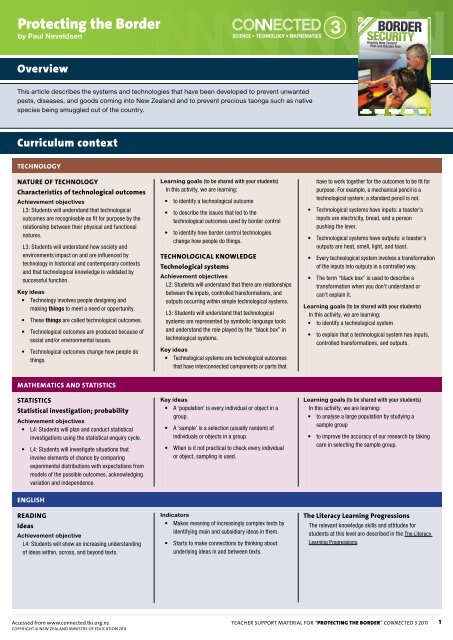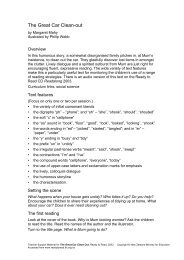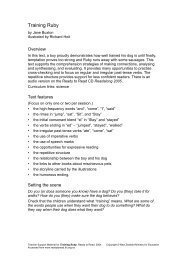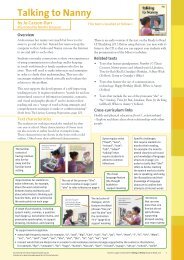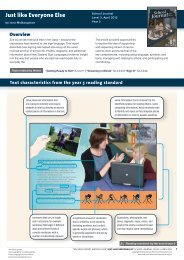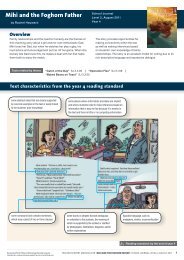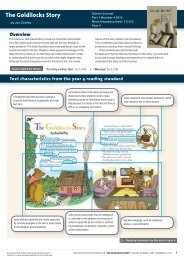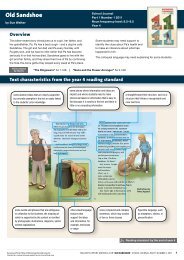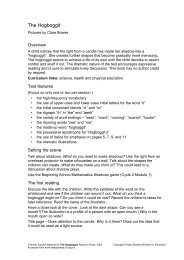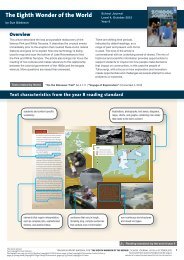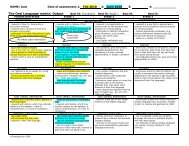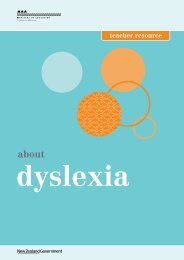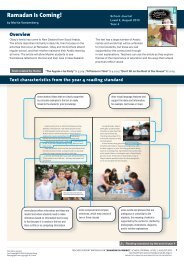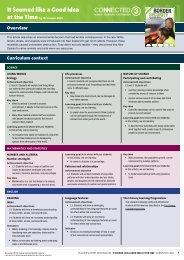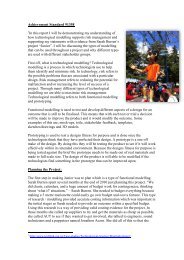Protecting the Border Connected 3 TSM (PDF 571KB) - Literacy Online
Protecting the Border Connected 3 TSM (PDF 571KB) - Literacy Online
Protecting the Border Connected 3 TSM (PDF 571KB) - Literacy Online
Create successful ePaper yourself
Turn your PDF publications into a flip-book with our unique Google optimized e-Paper software.
Exploring <strong>the</strong> technologyThe following activities and suggestions are designed as a guide for supporting students to developunderstandings about technological outcomes and technological systems.Key ideas• Technology involves people designing and making things to meet a need or opportunity• These things are called technological outcomes.• Technological outcomes are produced because of social and/or environmental issues.• Technological outcomes change how people do things.• Technological systems are technological outcomes that have interconnectedActivity 1: Identifying a technological outcomeBefore reading “<strong>Protecting</strong> <strong>the</strong> <strong>Border</strong>”, have a class discussion about what atechnological outcome is.Technology is when people design and make things that make <strong>the</strong>ir lives easier,meet a need, or solve a problem. Introduce <strong>the</strong> term “technological outcome”. Thethings created through technology are called technological outcomes.Discuss how technological outcomes are different from natural objects (for example,grass, people, rocks).After reading “<strong>Protecting</strong> <strong>the</strong> <strong>Border</strong>”, have <strong>the</strong> students work in small groupsto identify all <strong>the</strong> technological outcomes that were referred to in <strong>the</strong> article (forexample, cars, containers, ships, food items, planes, bags).Have a brainstorming session to list technological outcomes that are possibly usedwhen patrolling <strong>the</strong> border, including those not listed in <strong>the</strong> article (for example, anX-ray machine, fungicides, a fishing rod, protective overalls, a body temperaturescanner, CCTV, guns, traps, hutches, scales, herbicides, computers). Include itemsfrom <strong>the</strong> o<strong>the</strong>r articles in <strong>the</strong> book, assuming that your students have read <strong>the</strong>se.Have each group choose one technological outcome from <strong>the</strong> class list and determine:• What was <strong>the</strong> need/opportunity/problem that led to it being developed?Each group can <strong>the</strong>n present its findings to <strong>the</strong> class.Activity 2: Recognising that technological outcomes change howpeople do thingsAs a class discuss:• How was New Zealand’s border protected 50 years ago?• What about 100 years ago?Split <strong>the</strong> class into small groups. Allocate each group:• a technological outcome that is a modern way to patrol our border (for example,a body temperature scanner, an X-ray machine, and a computer)• a person who might be affected (for example, an immigrant, a border securityofficer, a smuggler).The group <strong>the</strong>n brainstorms <strong>the</strong> effects of that technological outcome on that person.De Bono’s thinking hats are a great way to encourage <strong>the</strong> students to considerdifferent views.Activity 3: Identifying a technological systemHave a class discussion about <strong>the</strong> meaning of <strong>the</strong> word “system”.• Discuss what a natural system is (for example, a digestive system).• Discuss what an organisational/social system is (for example, <strong>the</strong> Deweydecimal system used in <strong>the</strong> school library).• Ask <strong>the</strong> class to describe what <strong>the</strong>y think a “technological system” might be.Present <strong>the</strong> students with a collection of technological outcomes. It would be best topresent actual technological outcomes, but photographs can work just as well. Makesure that some of <strong>the</strong> technological outcomes are technological systems and some arenot. Make sure that <strong>the</strong> technological systems are a mix of electronic technologicalsystems (for example, a mobile phone) and mechanical technological systems (forcomponents or parts that have to work toge<strong>the</strong>r for <strong>the</strong> outcomes to be fit forpurpose. For example, a mechanical pencil is a technological system; a standardpencil is not.• Technological systems have inputs and outputs.• Every technological system involves a transformation of inputs into outputsin a controlled way.• The term “black box” is used to describe a transformation when you don’tunderstand or can’t explain it.example, a stapler). Include at least two items that are very similar but where one is atechnological system and one is not (for example, a pen and a pencil or an eggbeaterand a whisk).Explain to <strong>the</strong> students that you are going to organise <strong>the</strong> technologicaloutcomes into two groups, one a group of technological systems and one a groupof non-technological systems. Start with <strong>the</strong> two items that are very similar.As you sort <strong>the</strong> items, ask <strong>the</strong> students:What is <strong>the</strong> difference?Why is a pen a technological system but a pencil is not?Begin to discuss <strong>the</strong> definition of a technological system. A checklist is a good toolto help students identify a technological system.Technological systems:• have interconnected components or parts that have to work toge<strong>the</strong>r• have inputs• have outputs• involve a transformation of <strong>the</strong> inputs into outputs in a controlled way• might be started by a human, but <strong>the</strong> system does <strong>the</strong> rest.Return to <strong>the</strong> list of technological outcomes used for border security. Ask:Which ones are technological systems?Which ones aren’t? (These are just called technological outcomes.)On page 11, <strong>the</strong> article describes how an X-ray machine works. Use <strong>the</strong> informationto identify <strong>the</strong> inputs, transformation, and outputs of an X-ray machine. Record <strong>the</strong>information on a whiteboard.Inputs = electricity, bags.Transformation = The electricity causes <strong>the</strong> X-ray machine to send electromagneticrays towards <strong>the</strong> bags. These rays are picked up by two detectors. A computercircuit compares <strong>the</strong> two detectors and shows <strong>the</strong> image on a computer monitor.Outputs = X-rays (electromagnetic energy), images.In groups, <strong>the</strong> students can <strong>the</strong>n work toge<strong>the</strong>r to identify <strong>the</strong> inputs, transformation,and outputs for everyday technological systems (for example, a bicycle, a toaster, acomputer mouse, a hole punch).Explain that it is OK if you don’t understand <strong>the</strong> transformation that is happening in atechnological system. This means that <strong>the</strong> transformation is a “black box” for you.We use <strong>the</strong> term “black box” to describe <strong>the</strong> transformation when we don’tunderstand it or can’t explain it.A transformation that is a “black box” for you might not be a “black box” forsomeone else. For example, <strong>the</strong> transformation in <strong>the</strong> technological system of a carwon’t be a “black box” to a mechanic.Ministry of Education resources• http://www.techlink.org.nz/curriculum-support/papers/knowledge/techsystems/index.htmAccessed from www.connected.tki.org.nzCopyright © New Zealand Ministry of Education 2011Teacher support material for “protecting <strong>the</strong> border” <strong>Connected</strong> 3 20113
Exploring <strong>the</strong> ma<strong>the</strong>maticsThe following activities and suggestions are designed as a guide for supporting students to developma<strong>the</strong>matical understanding as <strong>the</strong>y explore ma<strong>the</strong>matical ideas associated with scientific research.Key ideas• A ‘population’ is every individual or object in a group.• A ‘sample’ is a selection (usually random) of individuals or objects in a group.• When is it not practical to check every individual or object, sampling is used.Ma<strong>the</strong>matical ideas and language• Vocabulary (population, sample, average, mean, random, percentage)• Units (hours, minutes, dollars).Focus questionsAt <strong>the</strong> beginning of <strong>the</strong> article, we are told that millions of people cross <strong>the</strong>New Zealand border annually. Suppose it took 15 minutes to thoroughly search <strong>the</strong>luggage of a visitor arriving in New Zealand:––How much time would it take one person to clear <strong>the</strong> passengers from a 747if it had a full load of 350 passengers?––How many staff would be needed if this number of people had to be clearedin one hour?––Do you think it would be practical to do this?Activity 1: Projecting from a sampleExplain to <strong>the</strong> students that in many situations, it is not possible to count every itemor person in a population and to sort <strong>the</strong>m according to some characteristic. This iswhere statistical sampling is used. We use a sample group that is chosen randomlyto determine a statistic such as <strong>the</strong> number of people who ski or <strong>the</strong> number ofpeople who keep rats as pets. Once we have that statistic (for example, apercentage), we <strong>the</strong>n use it to estimate how many people in <strong>the</strong> population havethat same characteristic.In this activity, <strong>the</strong> students will use sampling to work out how many students in<strong>the</strong>ir class are left-handed.• Each student writes <strong>the</strong>ir name on a piece of paper and all <strong>the</strong> names are placedin a jar.• They <strong>the</strong>n draw 10 names from <strong>the</strong> jar at random. The students whose namesare drawn become <strong>the</strong> sample group for <strong>the</strong> class population.• They <strong>the</strong>n find out how many of those whose names have been drawn are lefthandedand work out <strong>the</strong> percentage of <strong>the</strong> sample group that is left-handed.Ask: How many students are <strong>the</strong>re in <strong>the</strong> class? How many of <strong>the</strong>m are likely to beleft-handed?The students can <strong>the</strong>n repeat <strong>the</strong> experiment with ano<strong>the</strong>r class and go on torepeat it ano<strong>the</strong>r time with <strong>the</strong> two classes combined to make a bigger population.At this stage, <strong>the</strong>y can double <strong>the</strong> size of <strong>the</strong> sample group.Ask <strong>the</strong> students to compare <strong>the</strong> results of <strong>the</strong> bigger sample group with <strong>the</strong> resultsof <strong>the</strong> first experiment in <strong>the</strong>ir own class. (Generally, <strong>the</strong> bigger <strong>the</strong> sample group,<strong>the</strong> more accurate <strong>the</strong> estimation about <strong>the</strong> population will be.)The students can <strong>the</strong>n use <strong>the</strong> findings from <strong>the</strong> sample group to estimate <strong>the</strong> numberof left-handed students in <strong>the</strong> school. They could compare <strong>the</strong>ir results with nationalresults by visiting Census at School: www.censusatschool.org.nz/index.php.Accessed from www.connected.tki.org.nzCopyright © New Zealand Ministry of Education 2011Teacher support material for “protecting <strong>the</strong> border” <strong>Connected</strong> 3 20114


